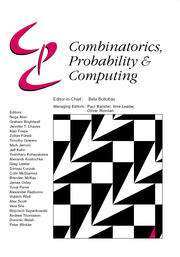No CrossRef data available.
Article contents
Embedding theorems for random graphs with specified degrees
Published online by Cambridge University Press: 16 October 2024
Abstract
Given an  $n\times n$ symmetric matrix
$n\times n$ symmetric matrix  $W\in [0,1]^{[n]\times [n]}$, let
$W\in [0,1]^{[n]\times [n]}$, let  ${\mathcal G}(n,W)$ be the random graph obtained by independently including each edge
${\mathcal G}(n,W)$ be the random graph obtained by independently including each edge  $jk\in \binom{[n]}{2}$ with probability
$jk\in \binom{[n]}{2}$ with probability  $W_{jk}=W_{kj}$. Given a degree sequence
$W_{jk}=W_{kj}$. Given a degree sequence  $\textbf{d}=(d_1,\ldots, d_n)$, let
$\textbf{d}=(d_1,\ldots, d_n)$, let  ${\mathcal G}(n,\textbf{d})$ denote a uniformly random graph with degree sequence
${\mathcal G}(n,\textbf{d})$ denote a uniformly random graph with degree sequence  $\textbf{d}$. We couple
$\textbf{d}$. We couple  ${\mathcal G}(n,W)$ and
${\mathcal G}(n,W)$ and  ${\mathcal G}(n,\textbf{d})$ together so that asymptotically almost surely
${\mathcal G}(n,\textbf{d})$ together so that asymptotically almost surely  ${\mathcal G}(n,W)$ is a subgraph of
${\mathcal G}(n,W)$ is a subgraph of  ${\mathcal G}(n,\textbf{d})$, where
${\mathcal G}(n,\textbf{d})$, where  $W$ is some function of
$W$ is some function of  $\textbf{d}$. Let
$\textbf{d}$. Let  $\Delta (\textbf{d})$ denote the maximum degree in
$\Delta (\textbf{d})$ denote the maximum degree in  $\textbf{d}$. Our coupling result is optimal when
$\textbf{d}$. Our coupling result is optimal when  $\Delta (\textbf{d})^2\ll \|\textbf{d}\|_1$, that is,
$\Delta (\textbf{d})^2\ll \|\textbf{d}\|_1$, that is,  $W_{ij}$ is asymptotic to
$W_{ij}$ is asymptotic to  ${\mathbb P}(ij\in{\mathcal G}(n,\textbf{d}))$ for every
${\mathbb P}(ij\in{\mathcal G}(n,\textbf{d}))$ for every  $i,j\in [n]$. We also have coupling results for
$i,j\in [n]$. We also have coupling results for  $\textbf{d}$ that are not constrained by the condition
$\textbf{d}$ that are not constrained by the condition  $\Delta (\textbf{d})^2\ll \|\textbf{d}\|_1$. For such
$\Delta (\textbf{d})^2\ll \|\textbf{d}\|_1$. For such  $\textbf{d}$ our coupling result is still close to optimal, in the sense that
$\textbf{d}$ our coupling result is still close to optimal, in the sense that  $W_{ij}$ is asymptotic to
$W_{ij}$ is asymptotic to  ${\mathbb P}(ij\in{\mathcal G}(n,\textbf{d}))$ for most pairs
${\mathbb P}(ij\in{\mathcal G}(n,\textbf{d}))$ for most pairs  $ij\in \binom{[n]}{2}$.
$ij\in \binom{[n]}{2}$.
Keywords
Information
- Type
- Paper
- Information
- Copyright
- © The Author(s), 2024. Published by Cambridge University Press


